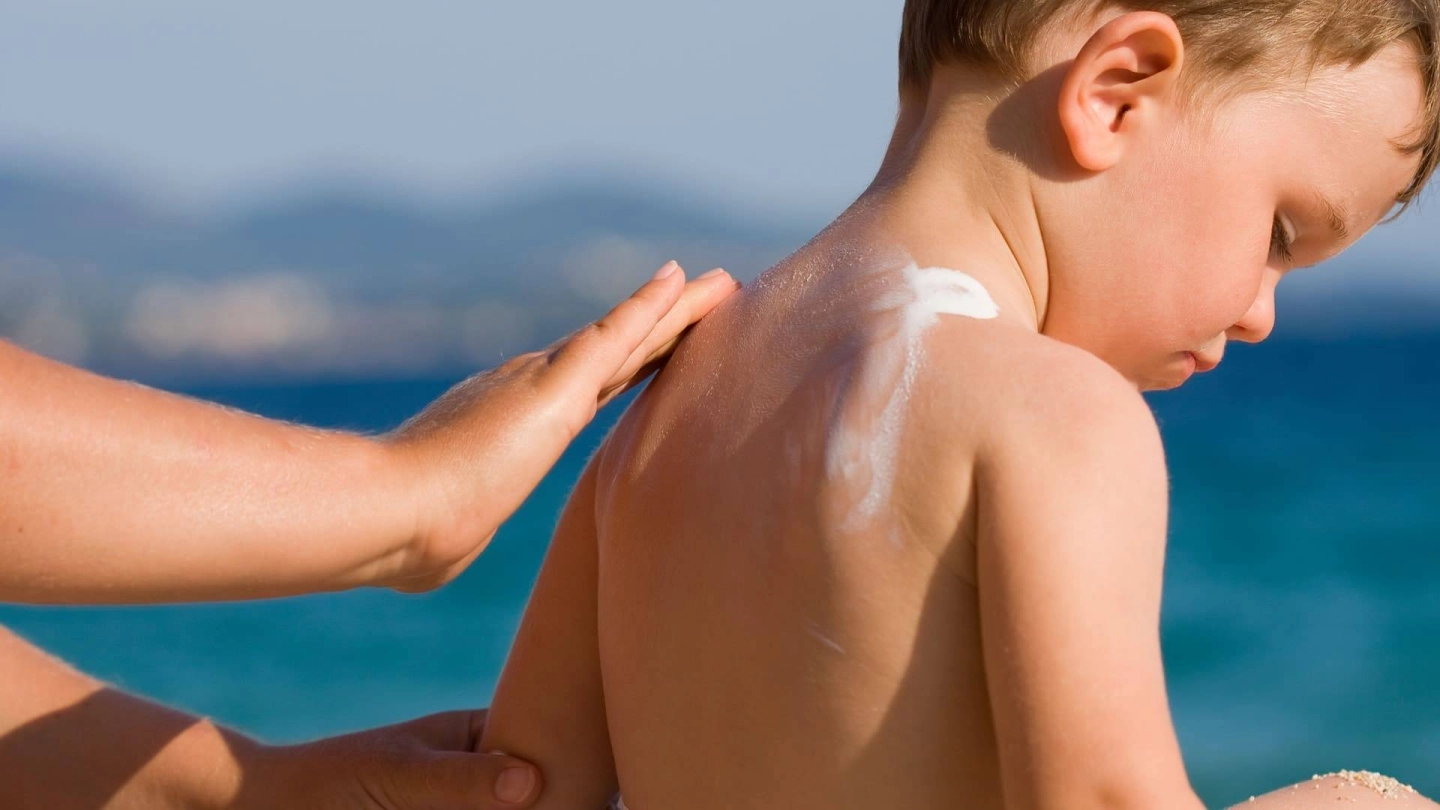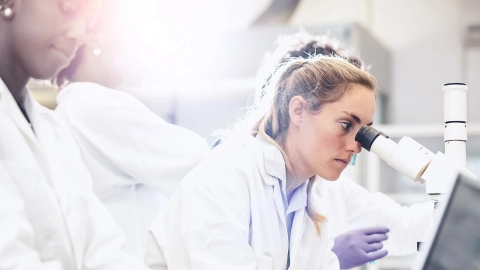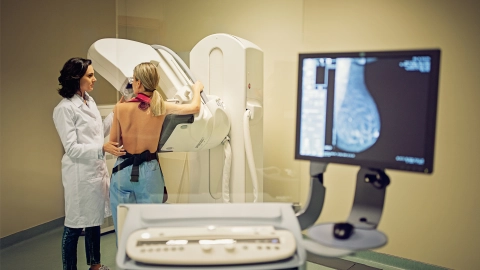Healthy living UV radiation: why it’s important to protect skin and eyes
There is no such thing as a healthy tan. Exposure to ultraviolet (UV) radiation is the primary risk factor for skin cancer. Children and people who work or spend a lot of time outdoors are most at risk. It’s best to use good UV protection and avoid tanning studios.
At a glance
- Exposure to high levels of UV light can cause lasting harm to the health of skin and eyes.
- Exposure to ultraviolet (UV) radiation is the primary risk factor for skin cancer. This applies to both natural and artificial sunlight.
- Taking precautions such as using sunscreen, wearing clothing that covers the skin and sunglasses prevents health problems due to UV radiation.
- UV protection is particularly important for children and people who work or spend a lot of time outdoors.
- The UV index is a useful guide to the risk of sunburn.
Note: The information in this article cannot and should not replace a medical consultation and must not be used for self-diagnosis or treatment.

What is UV radiation?
The body needs the sun’s ultraviolet (UV) rays to make vitamin D, which is essential, for example, for healthy bones. But the same invisible UV rays can also cause all sorts of damage to health: exposure to ultraviolet (UV) radiation is the primary risk factor for skin cancer. People who work or spend a lot of time outdoors are most at risk. Children also require special protection because their skin is so sensitive: studies show that many cases of skin cancer in adults were caused by damage from the sun in childhood.
There are a number of preventive measures that help reduce exposure to UV radiation. These include avoiding intense sunlight, wearing clothing that covers the skin, keeping one’s head covered and using sun cream and sunglasses. The UV index provided by the German Federal Office for Radiation Protection (Bundesamt für Strahlenschutz) is a useful guide to what UV protection is required: a high UV index means that UV radiation intensity levels are high and it will take less time for unprotected skin to suffer sunburn or the eyes to be damaged. Fair-skinned people in particular should protect themselves against intense sunlight.
Artificial UV radiation in tanning studios and solariums also increases the risk of skin cancer. German Cancer Aid (Deutsche Krebshilfe), the World Health Organization (WHO) and the Dermatological Prevention Working Group (Arbeitsgemeinschaft Dermatologische Prävention – ADP) advise against using tanning studios or solariums. Children and adolescents under 18 have been prohibited from using solariums in Germany since 2009.
What impact does UV radiation have on skin and eyes?
The impact that the sun’s UV rays or artificial UV rays in solariums have on our bodies depends on the type of ultraviolet radiation involved: short-wave UV rays have the highest levels of energy and can cause the greatest damage. Long-wave UVA rays have the lowest levels of energy but penetrate deeper into human tissue than the short-wave, higher-energy UVB rays. The very high-energy UVC radiation in sunlight is normally filtered out in the upper levels of the atmosphere and does not affect the body’s exposure to UV.
Skin and eye cells absorb the UV radiation and are affected by the rays. UVB radiation prompts the epidermal cells to produce the skin pigment melanin. The outcome of this process is visible after a few days as tanning. UVA radiation is responsible for the darkening of pre-existing melanin. Cell division increases and the cornea thickens when the body is exposed to high levels of UV. Although this delays onset of visible sunburn it does not prevent long-term cell damage.
The body’s natural system for repairing cells can repair damage to the genetic material. However frequent exposure to high levels of UV and recurring bouts of sunburn can lead to a situation where the damage caused cannot be completely reversed: permanent changes occur to the genetic material that may manifest as a number of conditions.
Video How does UV radiation affect the body?
This video explains the effects of UV radiation on the body and what people can do to protect themselves.
This and other videos can also be found on YouTube
Watch nowThe privacy policy indicated there applies.
What damage is caused by exposure to high levels of UV?
The sun’s ultraviolet rays and artificial UV radiation from solariums or other sources are carcinogenic. The International Agency for Research on Cancer (IARC) classes them as one of the primary risk factors for skin cancer.
UV radiation can cause short-term or long-term health problems. Short-term problems include sunburn and conjunctivitis. Long-term problems include premature skin aging, skin cancer and cataracts (gray star).
Eye damage due to UV radiation also includes:
- inflammation of the cornea (photokeratitis)
- inflammation of the conjunctiva (photoconjunctivitis)
- opacity of the ocular lens (cataract, gray star)
- retinal disorders (macular degeneration)
- choroidal melanoma (a cancer that effects the eye)
Exposure to high levels of UV can cause irregular pigmentation, increased wrinkling and damage to connective tissue. It also weakens the immune defense system. Rapidly visible damage due to exposure to high levels of UV radiation includes:
- sunburn (erythema)
- sun allergy
- phototoxic reactions
Risk of skin cancer due to UV radiation
Ultraviolet radiation can ultimately cause skin cancer in the worst case. The prevalence of skin cancers has been increasing for decades. Around one in seven men and one in nine women in Germany get skin cancer by the time they reach 75. Just under 4000 people die of complications due to skin cancer in Germany every year. These include:
- Basal cell carcinoma (basalioma): a slow-growing form of cancer that occurs mainly on the face, ears and scalp. It is only rarely life-threatening but can reduce quality of life considerably if, for example, it metastasizes into the bones.
- Squamous cell carcinoma (spinalioma): a malignant form of cancer which can form metastases once it reaches a certain size and occurs mainly on the face, backs of the hands and underarms.
- Melanoma (malignant melanoma): this is generally a brownish tumor that occurs all over the body, occasionally forms metastases at a very early stage and can be fatal if treated too late.
Basal cell carcinoma and squamous cell carcinoma are sometimes referred to as “white” or “bright” skin cancer. These tumors rarely metastasize and normally respond well to treatment. Melanoma is the most dangerous variant of skin cancer. Under certain circumstances its cells can spread rapidly throughout the body via the lymph system and the bloodstream.
Important: Two-yearly skin cancer screening examinations are available for anyone with statutory health insurance aged 35 or more for early detection of basal cell carcinoma, squamous cell carcinoma and melanoma.
When is the risk from UV particularly high?
UV radiation starts to damage the genetic material in the skin and eye cells well before any visible or noticeable effects appear. So constant readings are taken of UV intensity levels which are used to create the “UV index” that is included in many weather reports. A high UV index means that UV radiation intensity levels are high and it will take less time for unprotected skin to suffer sunburn or the eyes to be damaged.
The damage caused by UV rays depends on a number of different factors and behaviors:
- Midday sun: UV radiation increases as the sun rises in the sky. That’s why there is a higher risk of sunburn around midday.
- Solariums: solariums are not a suitable way of increasing the skin’s natural protection by tanning. In fact, exposure to the additional UV levels damages the skin.
- Reflected UV light: snow, large, bright areas of sand and water reflect and intensify the effect of the UV rays. This can cause corneal burns or “snow blindness” (photokeratitis). It manifests itself as pain, blurred vision, a burning or itching feeling.
- Flash burns: solariums, blow torches or welding arcs can also cause photokeratitis. This is also referred to as welder’s eye.
- Skin type: the skin’s sensitivity to UV radiation depends on the individual skin type. People with fairer skin are more likely to get sunburn than people with darker skin.
- Age: children’s and young people’s skin is particularly sensitive. Severe exposure to UV radiation and sunburn in childhood and adolescence cause lasting damage to the genetic material and increase the risk of contracting skin cancer.
- Medication: some medication reduces the skin’s natural protection and increases the risk of sunburn. This includes, for example, many antibiotics as well as certain diuretics.
- Cosmetic products: cosmetics, deodorants and perfumes can cause lasting pigmentation disorders in skin exposed to ultraviolet radiation.
- Working outdoors: people who are frequently exposed to UV radiation whilst working require special preventive measures. Working with artificial UV sources as used in dental practices or nail bars are also covered by special statutory regulations.
The German Federal Office for Radiation Protection (Bundesamt für Strahlenschutz – BfS) provides information on the various skin types.
How can you protect yourself against UV rays?
The BfS recommends taking preventive measures when the UV index is 3 or more (moderate). A combination of various measures provides effective protection against UV radiation and skin cancer:
- avoiding strong sunlight, particularly around midday
- protecting parts of the body that are exposed to the sun with clothing and head coverings
- there is special high sun protection factor (SPF) clothing to protect against UV radiation for people who regularly spend lots of hours in the sun
- using sun cream with UVA and UVB filters: at least sun protection factor (SPF) 30 for children, SPF 20 for adults and SPF 50 for people with sensitive skin
- use a very high sun protection factor (50+) when spending time at high altitudes, on snow or water and in sunny regions
- protect eyes with sunglasses designated “UV 400” or “100% UV protection”
- seek shade or stay at home if the UV index is higher than 8
Information about the UV index can be found on the website of the German Meteorological Service (DWD).
Special UV protection for children and adolescents
Babies must not be exposed to direct sunlight. Because of their sensitive skin they should stay in the shade and wear clothing that protects them against UV rays. Use of sun cream is not recommended in babies under 1 year of age. Baby oils can actually increase photosensitivity. Consistent use of sunscreen is also necessary for older children to avoid damaging their health. Use of solariums is prohibited in Germany for children and adolescents under the age of 18.
What to remember when using sun cream
Sunscreen products can delay onset of sunburn and prevent premature skin aging. But they don’t provide complete protection: the skin will still let in some of the UV rays even if you are using sun cream. As far as possible, use sun creams with a UVB and UVA filter.
What does the sun protection factor mean?
As well as the protection level (low, moderate, high and very high) on the label, the sun protection factor (SPF) is also stated as a number on most sunscreen products. It indicates how much longer you can stay in the sun without getting sunburn when you use the product. Someone who could stay in the sun for ten minutes without protection without getting sunburnt can multiply these ten minutes by the sun protection factor. The result equals the maximum number of minutes the sunscreen product can protect against sunburn.
To be effective, the cream or lotion needs to be spread generously all over the body. Most sunscreen products need to be applied 20 or 30 minutes before you start sunbathing to take effect. They should then be topped up every two hours, particularly after bathing.
Is sun cream harmful?
The ingredients of some sun creams and sun lotions can cause allergic reactions in sensitive people. Otherwise sunscreen products available in the European Union are unlikely to cause health problems. This is confirmed by the German Federal Institute for Risk Assessment (Bundesinstitut für Risikobewertung – BfR).
Further information about sunscreen products can be found on the website of the BfR.
Where should people go for more information?
Additional helpful information on UV protection and prevention of skin cancer is available from the Federal Center for Health Education (BZgA), German Cancer Aid (Deutsche Krebshilfe; in German) and the Federal Office for Radiation Protection (Bundesamt für Strahlenschutz, BfS).
- Arbeitsgemeinschaft der Wissenschaftlichen Medizinischen Fachgesellschaften (AWMF), Deutsche Krebsgesellschaft (DKG) und Deutsche Krebshilfe. Prävention von Hautkrebs. S3-Leitlinie. AWMF-Registernummer: 032/052OL. 09.2021.
- Baldermann C, Weiskopf D. Verhaltens- und Verhältnisprävention Hautkrebs. Der Hautarzt 2020. 71: 572-579.
- Bundesamt für Strahlenschutz. Warum Schutz vor UV-Strahlung. Aufgerufen am 21.01.2021.
- Deutsche Dermatologische Gesellschaft. „Gesunde Bräune gibt es nicht!“– Besserer Sonnenschutz vor allem für Kinder. Dermato-Onkologie mit weiteren Fortschritten im Kampf gegen den Hautkrebs. Aufgerufen am 21.01.21.
- Deutsches Krebsforschungszentrum in der Helmholtz-Gemeinschaft, Krebsinformationsdienst. Wie schädigt UV-Strahlung die Haut?
Aufgerufen am 21.01.2021. - Deutsche Krebshilfe. Gut geschützt vor UV-Strahlen. Aufgerufen am 21.01.2021.
- Zentrum für Krebsregisterdaten des Robert Koch-Instituts (RKI). Malignes Melanom der Haut. Aufgerufen am 21.01.2021.
- Zentrum für Krebsregisterdaten des Robert Koch-Instituts (RKI). Sommer, Sonne, Urlaub - mit effektivem Sonnenschutz den Sonnenschein genießen. Aufgerufen am 22.01.2021.
As at:






